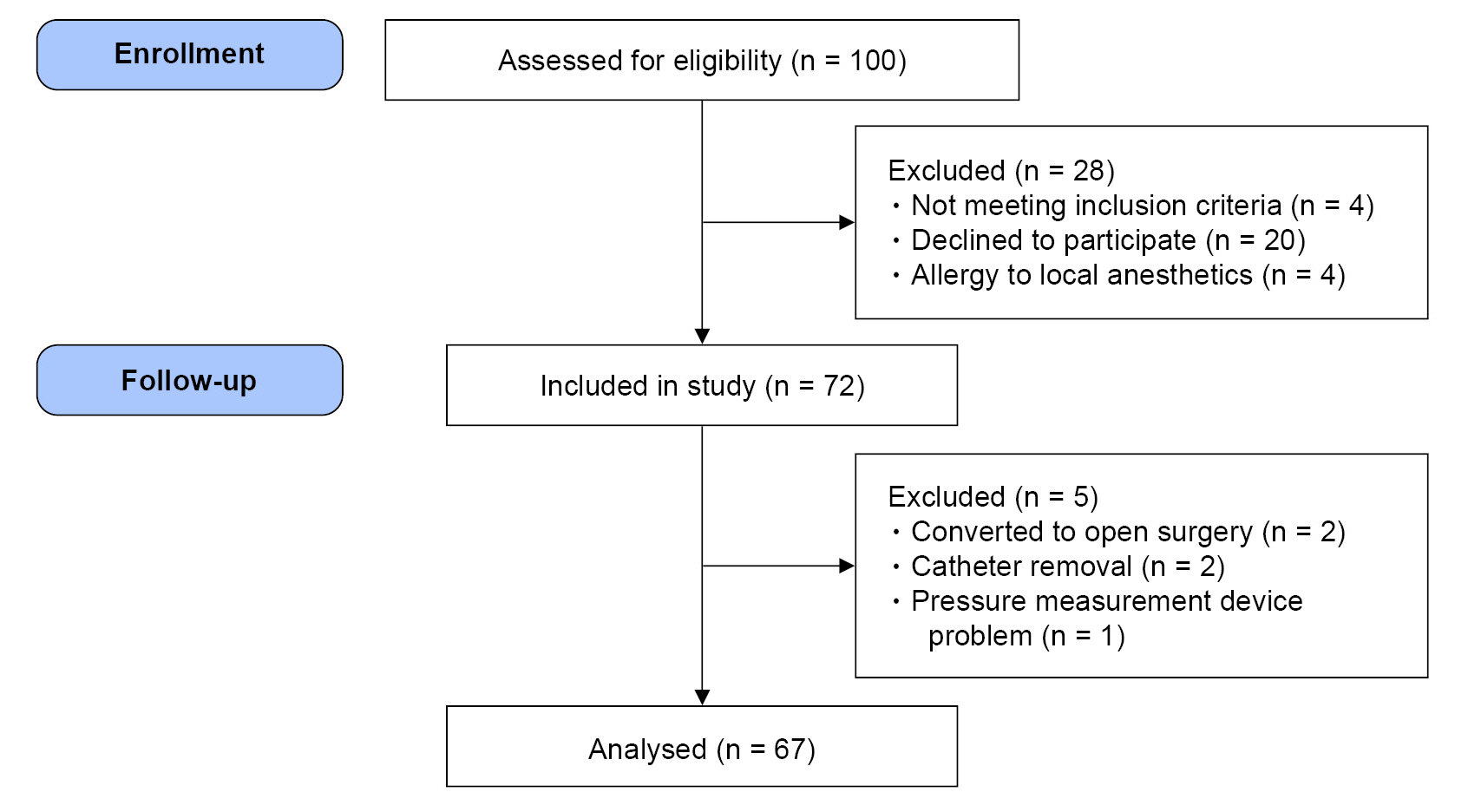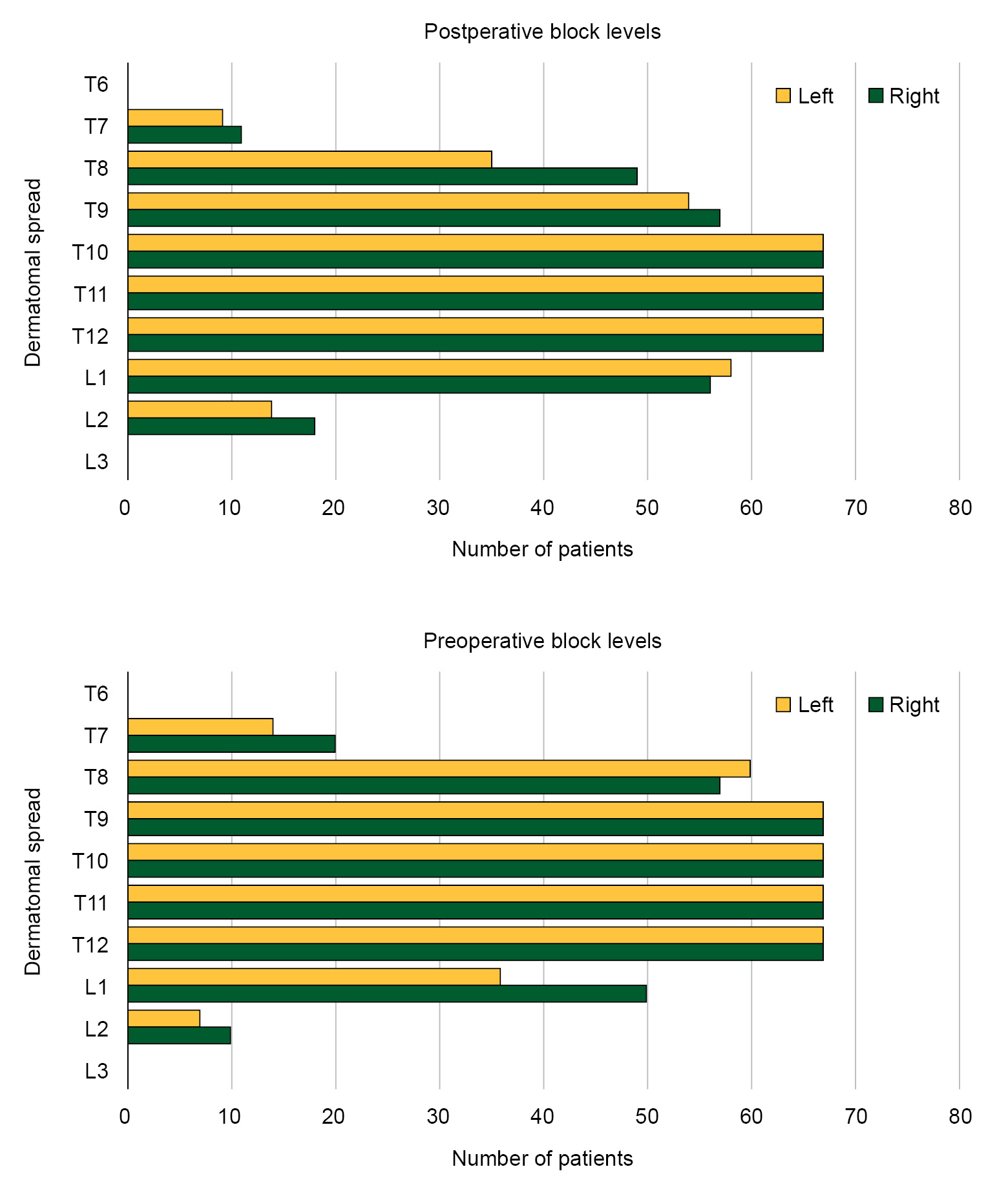Anesth Pain Med.
2023 Jul;18(3):307-314. 10.17085/apm.23010.
Effect of interfascial pressure on block success during anterior quadratus lumborum block application: a prospective observational study
- Affiliations
-
- 1Department of Anesthesiology and Reanimation, University of Health Sciences, Bursa Yuksek Ihtisas Training and Research Hospital, Bursa, Turkey
- KMID: 2547041
- DOI: http://doi.org/10.17085/apm.23010
Abstract
- Background
The quadratus lumborum block (QLB) has recently been used frequently for postoperative analgesia after abdominal surgery. The aim of this study was to investigate the effect of pressure changes between the middle thoracolumbar fascia layers to which the anterior QLB (aQLB) is applied at the level of the sensory block.
Methods
A total of 67 patients planned to undergo laparoscopic cholecystectomy were evaluated in the context of this prospective study. Bilateral aQLBs were administered to all patients, and a peripheral nerve block catheter was placed between the psoas and quadratus lumborum muscles. The correlation of interfascial pressures (IFPs) during block application, 30 min intraoperatively, and 30 min postoperatively with the sensory block level was determined as the primary outcome measure. Secondary outcome measures were the sensory block levels 30 min after block application and 30 min postoperatively; visual analog scale scores 30 min and 6, 12, and 24 h postoperatively; and 24 h tramadol consumption.
Results
The preoperatively and intraoperatively measured IFPs differed significantly between the right and left sides (P < 0.05). The preoperative and postoperative block levels also differed significantly between the right and left sides (P < 0.05). The preoperative and postoperative block levels and preoperatively measured IFPs showed a weakly negative correlation (right: r = 0.374; left: r = 0.470).
Conclusions
The results of this study show that pressure changes between the fasciae may be effective in aQLB application.
Keyword
Figure
Reference
-
1. Machi A, Joshi GP. Interfascial plane blocks. Best Pract Res Clin Anaesthesiol. 2019; 33:303–15.
Article2. Elsharkawy H, El-Boghdadly K, Barrington M. Quadratus lumborum block: anatomical concepts, mechanisms and techniques. Anesthesiology. 2019; 130:322–35.3. Uppal V, Retter S, Kehoe E, McKeen DM. Quadratus lumborum block for postoperative analgesia: a systematic review and meta-analysis. Can J Anaesth. 2020; 67:1557–75.
Article4. Blanco R. The mechanism of the quadratus lumborum block: A peripheral sympathetic field block? Br J Anaesth. 2016; 117:EL_13593.
Article5. Willard FH, Vleeming A, Schuenke MD, Danneels L, Schleip R. The thoracolumbar fascia: anatomy, function and clinical considerations. J Anat. 2012; 221:507–36.
Article6. Børglum J, Moriggl B, Jensen K, Lønnqvist PA, Christensen AF, Sauter A, et al. Ultrasound-guided transmuscular quadratus lumborum blockade. Br J Anaesth. 2013; 111:EL_9919.
Article7. Faul F, Erdfelder E, Buchner A, Lang AG. Statistical power analyses using G*Power 3.1: tests for correlation and regression analyses. Behav Res Methods. 2007; 41:1149–60.
Article8. Chin KJ, Lirk P, Hollmann MW, Schwarz SKW. Mechanisms of action of fascial plane blocks: a narrative review. Reg Anesth Pain Med. 2021; 46:618–28.
Article9. Vamnes JS, Sörenstua M, Solbakk KI, Sterud B, Leonardsen AL. Evaluation of quadratus lumborum block after laparoscopic cholecystectomy. Reg Anesth Pain Med ESRA19-0268. 2019; 44:A123.10. Ökmen K, Metin Ökmen B, Topal S. Ultrasound-guided posterior quadratus lumborum block for postoperative pain after laparoscopic cholecystectomy: A randomized controlled double blind study. J Clin Anesth. 2018; 49:112–7.
Article11. Zhu M, Qi Y, He H, Lou J, Pei Q, Mei Y. Analgesic effect of the ultrasound-guided subcos-tal approach to transmuscular quadratus lumborum block in patients undergoing laparoscopic nephrectomy: a randomized controlled trial. BMC Anesthesiol. 2019; 19:154.
Article12. Rahendra R, Pryambodho P, Aditianingsih D, Sukmono RB, Tantri A, Melati AC. Comparison of IL-6 and CRP concentration between quadratus lumborum and epidural blockade among living kidney donors: a randomized controlled trial. Anesth Pain Med. 2019; 9:e91527.
Article13. Carline L, McLeod GA, Lamb C. A cadaver study comparing spread of dye and nerve involvement after three different quadratus lumborum blocks. Br J Anaesth. 2016; 117:387–94.
Article14. Adhikary SD, El-Boghdadly K, Nasralah Z, Sarwani N, Nixon AM, Chin KJ. A radiologic and anatomic assessment of injectate spread following transmuscular quadratus lumborum block in cadavers. Anaesthesia. 2017; 72:73–9.
Article15. Dam M, Moriggl B, Hansen CK, Hoermann R, Bendtsen TF, Børglum J. The pathway of injectate spread with the transmuscular quadratus lumborum block: a cadaver study. Anesth Analg. 2017; 125:303–12.
Article16. Elsharkawy H. Quadratus lumborum block with paramedian sagittal oblique (subcostal) approach. Anaesthesia. 2016; 71:241–2.
Article17. Sondekoppam RV, Ip V, Johnston DF, Uppal V, Johnson M, Ganapathy S, et al. Ultrasound-guided lateral-medial transmuscular quadratus lumborum block for analgesia fol-lowing anterior iliac crest bone graft harvesting: a clinical and anatomical study. Can J Anaesth. 2018; 65:178–87.
Article18. Diwan S, Kulkarni M, Kulkarni N, Nair A. A radiological inquest to determine the destiny of ultrasound guided trans-muscular quadratus lumborum plane catheters. Indian J Anaesth. 2019; 63:667–70.
Article19. Hodges PW, Eriksson AM, Shirley D, Gandevia SC. Intra-abdominal pressure increases stiffness of the lumbar spine. J Biomech. 2005; 38:1873–80.20. El-Monajjed K, Driscoll M. A finite element analysis of the intra-abdominal pressure and paraspinal muscle compartment pressure interaction through the thoracolumbar fascia. Com-put Methods Biomech Biomed Engin. 2020; 23:585–96.
Article21. Chen YH, Chai HM, Shau YW, Wang CL, Wang SF. Increased sliding of transverse abdo-minis during contraction after myofascial release in patients with chronic low back pain. Man Ther. 2016; 23:69–75.22. Ranger TA, Teichtahl AJ, Cicuttini FM, Wang Y, Wluka AE, OʼSullivan R, et al. Shorter lumbar paraspinal fascia is associated with high intensity low back pain and disability. Spine. 2016; 41:E489–93.
- Full Text Links
- Actions
-
Cited
- CITED
-
- Close
- Share
- Similar articles
-
- Ultrasound-guided anterior quadratus lumborum block for postoperative pain after percutaneous nephrolithotomy: a randomized controlled trial
- Single puncture combined lumbar erector spinae plane and quadratus lumborum block (SEQ block) in acetabular fracture surgeries: randomized clinical trial
- Ultrasound-guided truncal blocks for perioperative analgesia
- Analgesic effects and distribution of cutaneous sensory blockade of quadratus lumborum block type 2 and posterior transversus abdominis plane block: an observational comparative study
- Thoracic interfascial nerve block for breast surgery in a pregnant woman: a case report





